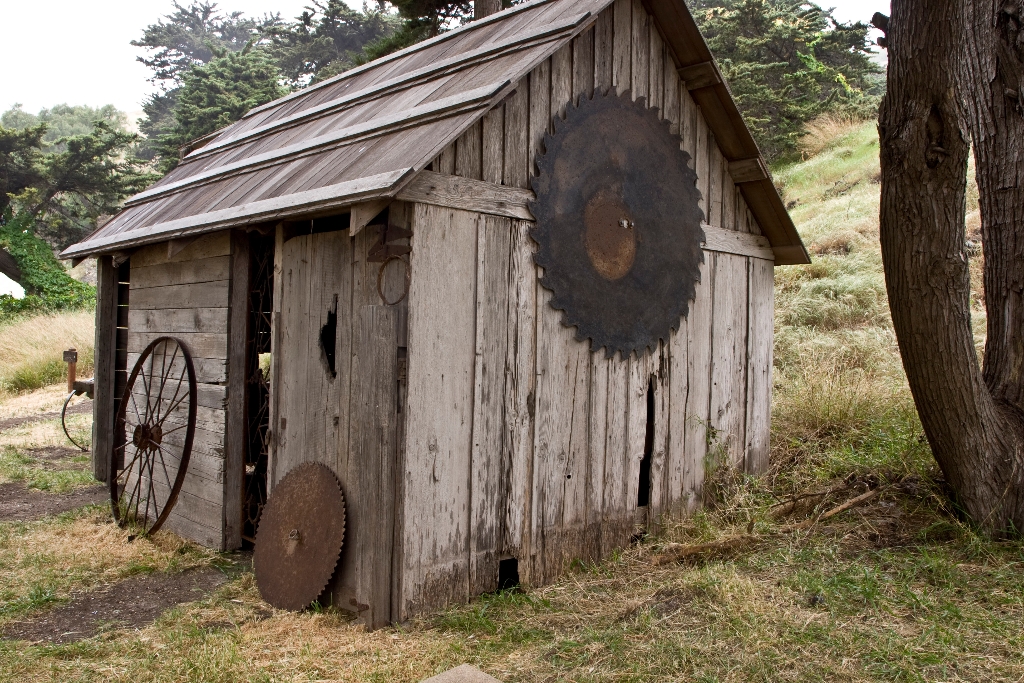
Archeological excavations around and within this building revealed artifacts and materials that suggested that this may have been the location of the"forge" or blacksmith shop shown on an 1892 map. In addition to a distinct layer of ash that was discovered, the excavation also revealed other materials that easily could be associated with the craft of blacksmithing, including bits of charcoal, fused and oxidized metal, chunks of mixed ash, charcoal debris, several horse shoes, nails, and a pair of rusty pliers. Built sometime between 1885-1892, this shop is one of the oldest wood buildings on the east end of the island.
Despite being built on a small bench above the flood plain, years of flooding and deposition had caused the structure to tilt significantly to the south and by 1998 it was on the verge of collapse. Park staff stabilized the building and added a new roof to preserve it.
Today, this shop helps to remind us of the unique island ranching operation and the important role that blacksmiths played in it. With the nearest mainland blacksmith over 25 miles away, it was essential to have working shops on the island to repair the equipment, fix and sharpen tools, and shoe horses.
A Day at the Shop
The blacksmith shop was a hot, noisy, sweaty place, but it played a key role at Scorpion Ranch.
An isolated ranch needed to be self-sufficient - a blacksmith shop made this possible. The blacksmith was kept busy making or repairing Scorpion's tools and gear. Everything with metal parts passed through the smithy - on a given day the blacksmith might shoe horses, repair wagon wheels, sharpen plows and make oar locks.
Basic blacksmithing didn't require much - only a hot fire, simple tools and brute strength.
"Forging" is changing the shape of a piece of metal by heating and hammering it.
It's a very physical process. Although the Scorpion blacksmith shop was probably operated by one person, an assistant "striker" may have added his blows when vigorous hammering was needed. Leg vises anchored to the floor gave the blacksmith extra support when hammering.
Tools of the Trade
Grindstone: The blacksmith held a tool against the stone to sharpen it. Foot pedals made
it easier to keep the stone turning.
Anvil: An anvil is the iron block on which the blacksmith works metal. To keep it steady, this anvil was mounted on a sturdy log embedded in the dirt floor.
Portable forge: Not all blacksmithing at Scorpion took place in the shop. The portable hand forge and leg vise were taken out into the field, probably for shoeing horses.
How to Make a Horseshoe
1. Build a fire in the forge. Use blacksmithing coal, (a soft coal, free from impurities).
When packed down around the fi re, it changes to coke, a lightweight material that burns with a clean, intense flame.
2. Use the shovel and poker to adjust the fire.
3. Use your left hand to work the bellows or crank the blower to add
oxygen to the fire so it burns hotter.
4. Stick the iron bar into the forge to heat.
5. Heat the section you'll be working onto a bright-red heat, almost but not quite white hot.
6. Using the tongs, draw the iron bar out of the fire and turn to the anvil.
7. Pick up a small hammer.
8. Using the round face of the hammer, bend the iron bars over the anvil.
9. Once the horseshoe is the right shape, start the nailholes using a forepunch. The shape of the punch should exactly match the head of the nail.
10. Hammer a stamp into the hole to make a space for the shank of the nail.
11. Sharpen the pritchel on the grindstone. To complete the hole, hammer a pritchel into the hole. A little piece will drop out.
12. Lay the shoe flat on the anvil and hammer all around to level.
The "Smith"
A versatile blacksmith - really a jack-of-all-trades - was essential to Scorpion's self-sufficient ranch operation.
"Felix Mauri was an able iron worker. During his time, we still used draft horses and wagons and the skill of an iron worker was always in demand. In addition to repair of plows, wagons, sleds, there was of course horse shoeing and other related jobs. With Felix, breakfast was an important meal. Each morning he would have a "rosetta", consisting of four raw eggs and a glass of wine mixed together. - A quote by Pier Gherini
A Gang of Blacksmiths
The Scorpion smith was in good company - there were once six blacksmith shops on the island. Blacksmiths at the satellite ranches, or outranches, dealt with day to day objects, while hinges, ornamental ironwork and railings were made at the main ranch blacksmith shop.
Is there something we missed for this itinerary?
Itineraries across USA


















































